Nothing ruins a good trail ride faster than watching steam puff out of your engine like it’s boiling a pot of noodles. Your four-wheeler should be tearing through mud, not gasping for breath like it just ran a marathon.
When your machine starts running hot, it’s not just being dramatic — it’s warning you that something serious is brewing under the hood. Ignore it, and you could end up with a warped head gasket, fried radiator, or a very sad-looking repair bill.
If your ATV engine is overheating, running hot, or losing power after a few minutes of riding, this guide will help you find out why. We’ll walk through the warning signs, the sneaky culprits, and how to cool things down before your engine decides to self-destruct.
So, let’s kick things off by spotting how to tell when your ride is actually overheating — because half the battle is catching the signs early.
Read: What to Do If ATV Makes Buzzing Sound When Trying to Start
Jump To Contents
Common Symptoms of an Overheating ATV
1. Steam or smoke from the engine:
If your ride starts looking like a barbecue grill, it’s not celebrating — it’s overheating. Steam usually means your radiator or coolant reservoir is under pressure and boiling over.
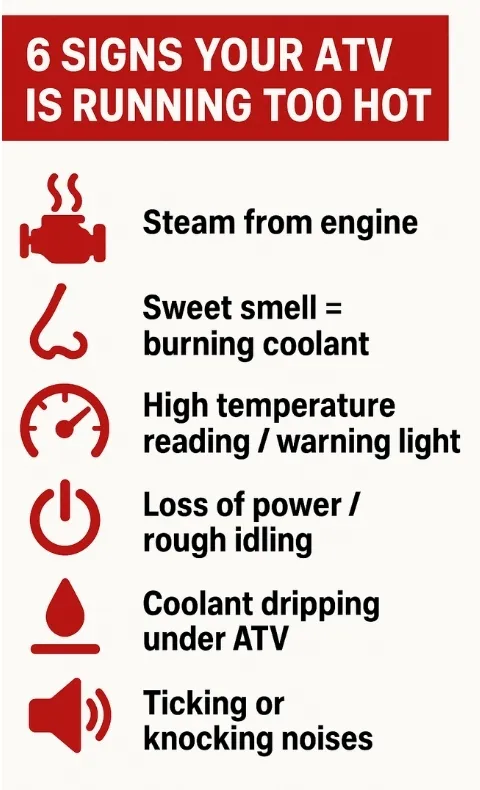
2. Sweet smell (burning coolant or antifreeze):
That sugary scent in the air? Not pleasant. It’s the smell of coolant leaking or burning off somewhere it shouldn’t — often a sign of a failing hose or loose cap.
Spotting the signs early can mean the difference between a quick fix and a cooked engine. Thankfully, your machine drops a few hints before it throws a full-blown tantrum.
3. Temperature gauge or warning light flashing:
If the engine temperature gauge climbs faster than your heartbeat on a steep hill, pay attention. Many modern ATVs also throw an overheat warning light, so don’t ignore that glowing red symbol.
4. Loss of power or rough idling:
When your engine gets too hot, it starts pulling back power to protect itself. You might feel sluggish acceleration, jerky idling, or that weird sense your ATV is “tired.”
5. Coolant leaking underneath:
A green or orange puddle under your ATV is never good news. It could mean a cracked radiator hose or a leaky water pump seal — both of which demand attention before the next ride.
6. Ticking or knocking sounds:
Those sharp metallic noises? They’re your engine’s way of saying, “I’m not happy.” Overheated parts expand, creating gaps and friction where there shouldn’t be any.
Now that you know how to recognize when your ride’s running too hot, let’s move on to the real question — what’s causing it to boil over in the first place?
Read: How to Tell If the Starter Solenoid is Bad on Your ATV
Main Causes of an Overheating ATV
Overheating isn’t usually a single “aha!” problem — it’s more like a messy group project where several parts fail to cooperate. Your cooling system, airflow, and riding habits all play a role in how hot your engine runs.
Let’s break it down, one culprit at a time.
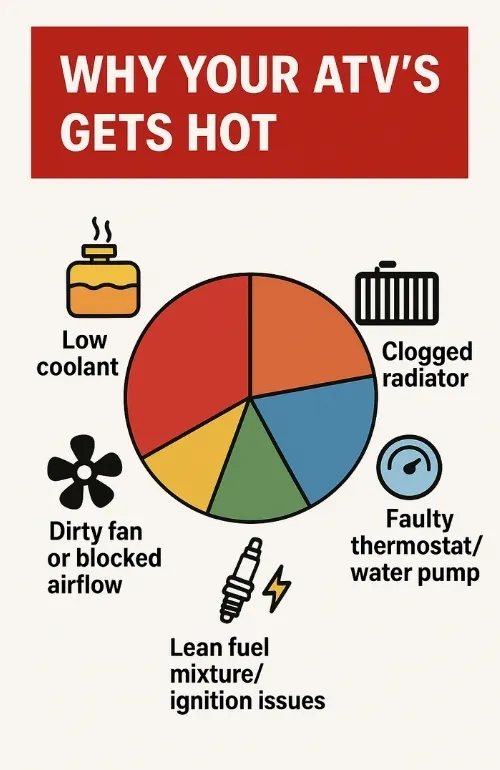
1. Cooling System Problems
The cooling system is your ATV’s version of an air conditioner — except instead of cooling you down, it keeps the engine from melting into scrap.
Low Coolant Level: If the coolant reservoir looks emptier than your wallet after a parts run, that’s your first red flag. Low levels create air pockets that block circulation, leaving hot spots that cook your engine from within. Always top it up and check for sneaky leaks.
Coolant Leak or Poor Mixture: Coolant isn’t just dyed water — it’s a science. The wrong antifreeze ratio or worn hoses can make it less effective. If you see stains around fittings or hoses, you’re probably losing coolant faster than you realize.
Clogged Radiator or Fins: A radiator covered in mud, leaves, or corrosion might as well be a brick wall. When airflow is blocked, heat stays trapped. A gentle rinse or compressed air can clear it out — but never use high pressure unless you want bent fins and bigger problems.
Thermostat Failure: A lazy thermostat that’s stuck open won’t let the engine reach the right temp; stuck closed, and it’s game over for coolant flow. Test or replace it if you notice inconsistent temperature readings.
Water Pump Issues: The water pump is the unsung hero of your cooling circuit. A damaged impeller or failing seal stops coolant from circulating, making the engine boil in its own juices. If you see coolant dripping under the pump housing, time for a replacement.
2. Airflow and Fan Issues
You can have perfect coolant levels and still overheat if the air can’t move freely.
Cooling Fan Not Working: If the radiator fan doesn’t kick in when things get toasty, check the fan sensor and electrical connections. No airflow equals no cooling, especially during slow rides or when idling.
Blocked Air Vents: Sometimes it’s the simple stuff — a face full of mud, tall grass stuck in the grille, or even aftermarket guards restricting airflow. Keep those vents clean so the radiator can actually breathe.
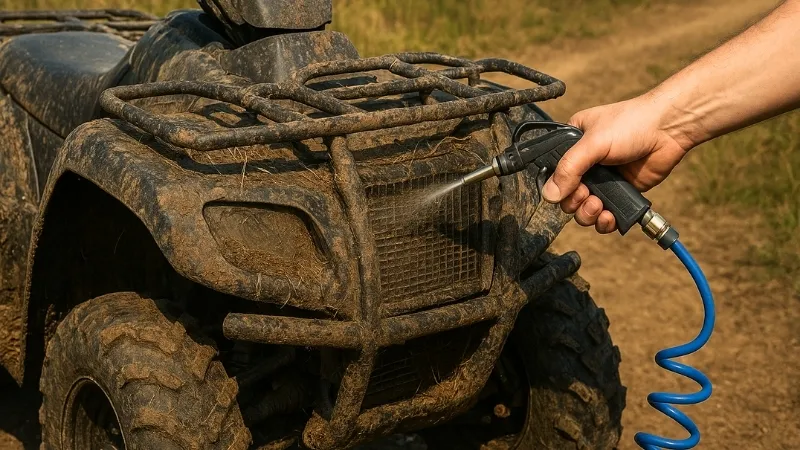
3. Engine & Fuel System Problems
Engines that burn fuel inefficiently generate more heat — and not in the “extra horsepower” kind of way.
Lean Fuel Mixture: Too much air and too little fuel = hotter combustion. This “lean” setup can cause the engine to run hot even when the cooling system is fine. Adjusting the fuel mixture or tuning your EFI can bring the temperature back down. Thus, you can avoid ATV not backfiring or stalling mid-journey.
Bad Spark Plug or Ignition Timing: A weak spark plug or misaligned ignition system can cause incomplete combustion (leading your ATV not to start), meaning extra fuel burns in the exhaust instead of the cylinder. That leftover heat doesn’t just disappear — it bakes your engine.
4. Environmental and Riding Conditions
Sometimes, it’s not your machine’s fault — it’s where and how you ride.
Heavy Loads or Towing: Hauling a trailer or climbing steep hills puts extra strain on the engine. More effort means more heat. Take breaks between heavy runs to let things cool down.
Slow Riding or Idling Too Long: Crawling through trails or long idling kills airflow, especially if your fan isn’t working properly. Without fresh air, the radiator turns into a sauna.
Hot Weather or High Altitude: When the air’s thin or scorching, your radiator struggles to shed heat. Riding in these conditions calls for shorter runs and regular temperature checks.
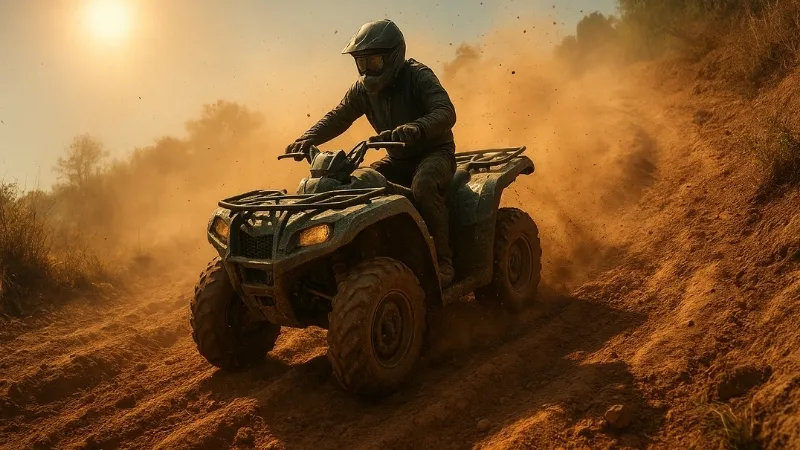
5. Lack of Maintenance
Neglect is the silent killer of engines.
A dirty radiator, old coolant, or skipped oil changes all build up to one predictable result — rising temperatures. Even using the wrong coolant type for your brand (like mixing a Polaris formula with Yamaha’s) can mess with corrosion protection and heat transfer.
Now that you know what’s heating things up, it’s time to tackle the practical part — how to fix it before your next ride turns into a steam show.
Read: Guide to Start an ATV – With & Without Key
How to Fix an Overheating ATV
Once you’ve spotted the troublemaker, the fix is usually straightforward. Most heat problems come down to coolant flow or airflow — in other words, keeping things moving and breathing properly. Here’s how to cool that hot-headed engine back down.
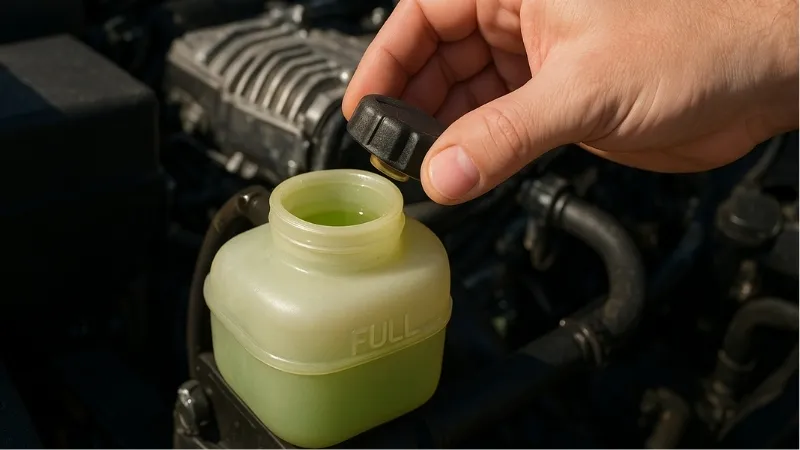
Step 1: Check the Coolant Level and Condition
Start simple. Pop open the coolant cap (when the engine is cool — no hero moves here) and check the level.
If it’s low, top it off with the proper antifreeze mix your ATV manufacturer recommends. Plain water might work in an emergency, but it’ll corrode your system faster than you can say “radiator flush.”
Next, inspect around the hoses, radiator cap, and water pump for leaks or crusty residue. Any green or orange gunk means coolant’s escaping — fix the leak before it gets worse.
Step 2: Inspect the Radiator and Cooling Fins
Your radiator fins are like your ATV’s lungs — if they’re clogged, it can’t breathe.
Gently clean them using compressed air or a soft brush. Avoid blasting them with a power washer; bent fins trap heat instead of releasing it.
Check for mud, debris, or grass blocking airflow from the front grille. Even a thin layer of dirt can mess with cooling efficiency.
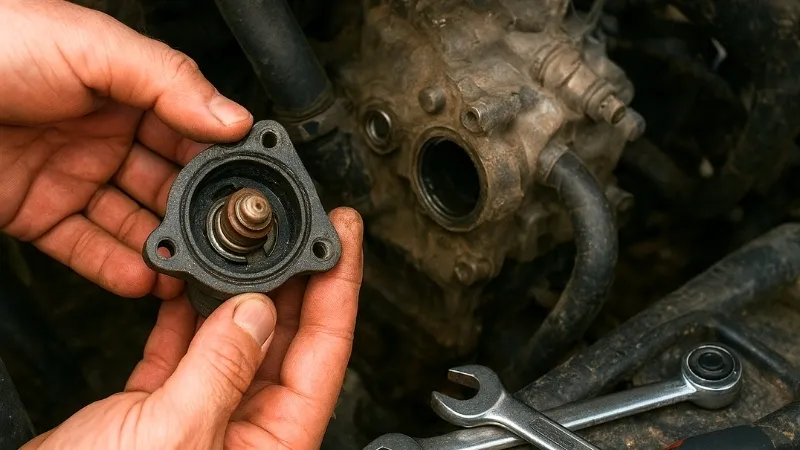
Step 3: Test the Fan and Thermostat
Turn on your ignition and let the machine idle for a few minutes. You should hear the cooling fan kick on as the temperature rises.
If it stays silent, inspect the fan relay, wiring, and sensor — chances are one of them is snoozing on the job.
Next, remove the thermostat and dunk it in hot water (around 180°F). If it doesn’t open or close smoothly, it’s toast. Replace it before your next ride.
Step 4: Check for Water Pump and Hose Damage
The water pump keeps coolant flowing through the engine, so a failure here is like losing circulation in your veins.
Check for cracked or bloated hoses, loose clamps, or any residue near the pump housing. If coolant is dripping from the weep hole, it’s time for a new seal or impeller.
Step 5: Examine the Fuel and Ignition Systems
If your engine’s still running hot after all that, the issue might be combustion-related. Pull the spark plugs — if they’re dark, oily, or crusty, replace them. A dirty plug can throw off timing and make the engine burn inefficiently.
Also, check your fuel mixture or EFI settings. A lean burn (too much air, too little fuel) creates excessive heat and can easily mimic a cooling system failure.
Fixing the problem is one thing, but keeping it from happening again is the real win. Let’s move on to some simple habits that’ll keep your ATV running cool no matter the trail or weather.
Preventing Future Overheating
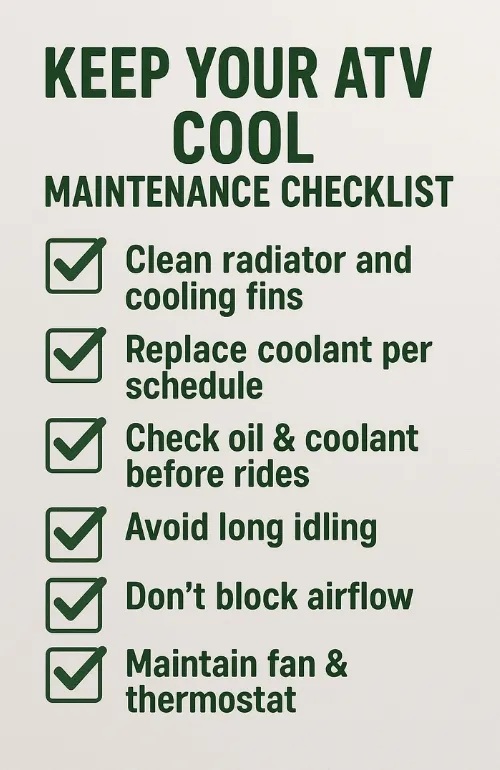
Fixing an overheating ATV is one thing — but keeping it from happening again? That’s the real win. Preventive care costs a fraction of what a new engine would, and it keeps your rides smooth and stress-free.
1. Regularly clean the radiator and cooling fins.
Dirt and mud clog up airflow faster than you’d think. After muddy rides, spray your radiator with low-pressure water and gently clean the fins. Keeping airflow unrestricted ensures consistent cooling performance.
2. Use high-quality coolant and replace it per the manufacturer’s schedule.
Stick to your maintenance schedule — most ATVs need a coolant flush every 1–2 years. Cheap or old coolant loses its corrosion resistance and boiling point, which means less protection for your engine.
3. Check oil and coolant before long rides.
Before hitting the trail, give both fluids a quick look. Low levels can lead to engine stress, poor lubrication, and ultimately overheating. It’s a 2-minute check that can save you a lot of headaches later.
4. Don’t idle for long periods.
ATVs aren’t made to sit running in one place. When there’s no forward motion, airflow through the radiator drops, making it harder for the system to cool down — especially in hot weather.
5. Avoid blocking radiator airflow with bags or mudguards.
Mounting gear too close to the front can trap heat. Always keep the front vents clear to let the air circulate freely.
6. Maintain the fan and thermostat regularly.
Test the fan and thermostat at least once a season. A stuck thermostat or burnt fan relay can quietly cause overheating without obvious signs until it’s too late.
When to Seek Professional Help
Sometimes, overheating isn’t caused by something you can fix with basic tools. If your ATV keeps running hot after all the usual maintenance checks, it’s time to call in a pro. Ignoring deeper issues can lead to blown gaskets or even a cracked engine block — both expensive repairs you don’t want.
1. Persistent overheating even after cleaning and refilling fluids.
If you’ve flushed the coolant, checked the thermostat, and cleaned the radiator but the problem keeps returning, there may be a blocked cooling passage or internal damage to the water pump or head gasket.
2. Coolant loss without visible leaks.
If your coolant level keeps dropping and there’s no sign of a leak, it could mean internal coolant leakage into the combustion chamber. A mechanic can perform a pressure test or compression test to confirm this.
3. Electrical or sensor-related issues.
Modern ATVs rely on temperature sensors, fan relays, and ECU controls to manage cooling. Faulty sensors or wiring problems can prevent the fan from kicking in when needed — something that’s tricky to diagnose without proper equipment.
4. Overheating right after starting or at random times.
This may point to air trapped in the cooling system, a failed thermostat, or radiator blockage. A technician can bleed the system correctly and identify the exact fault.
If your ATV’s overheating issues are recurring despite all preventive measures, don’t delay getting it checked — a professional diagnosis early on can prevent engine failure later.
Key Takeaways
- Overheating isn’t random — it’s usually caused by low coolant, poor airflow, or a dirty radiator.
- Watch for the warning signs: steam, sweet smell, temperature gauge spiking, or power loss.
- Coolant first, panic later. Check the coolant level and radiator before blaming the engine.
- Clean radiators = happy engines. Mud, grass, or debris blocking fins is a silent heat trap.
- Fans and thermostats matter. A broken fan or stuck thermostat can turn a good ride into a meltdown.
- Don’t ignore fuel and spark issues. A lean mixture or bad spark plug can make your engine run hotter.
- Preventive care is cheaper than repair. Regular cleaning, coolant changes, and inspections go a long way.
- When in doubt, call a pro. Persistent overheating could mean deeper problems like a blown gasket or pump failure.
Bottom line: keep your ATV’s cooling system clean, fluids fresh, and airflow unobstructed — your engine (and wallet) will thank you.
Wrap-up: Keep Your ATV Cool, Keep the Fun Rolling
Overheating usually boils down to two things: a cooling system that’s not doing its job and maintenance that’s been neglected. Most issues can be caught early by keeping an eye on your coolant, radiator, and airflow before they turn into costly engine repairs.
A quick check and a bit of TLC can save you from a fried engine and a sad wallet. Check your coolant today — your ATV’s engine (and wallet) will thank you.
FAQs to Know More About ATV Overheating
1. Can low coolant really cause my ATV to overheat?
Absolutely. Coolant is what carries heat away from your engine. If it’s low, air pockets form and circulation drops — meaning the engine runs hot, fast. Always check coolant before rides, especially after long storage.
2. What coolant should I use for my ATV?
Stick to what your manufacturer recommends. Using generic or mixed coolants can cause chemical reactions that clog the system. Brands like Honda HP Coolant, Polaris 50/50, or Engine Ice are solid choices. Never use plain tap water — it causes corrosion.
3. Why does my ATV overheat only at low speeds or when idling?
That usually means poor airflow. When you’re moving, the radiator gets plenty of air; when you’re idling, it relies on the fan. Check whether your fan sensor, relay, or fan motor is working.
4. How do I know if my thermostat is bad?
If your engine overheats too quickly or never reaches normal temperature, the thermostat could be stuck closed or open. You can remove it and test it in hot water — it should open as the temperature rises.
5. Can a dirty radiator really make that much difference?
Yes, 100%. Mud, leaves, or even dry grass can block airflow and trap heat. Cleaning the radiator fins gently with air or water pressure can instantly improve cooling performance.
6. What happens if I keep riding while it’s overheating?
That’s a fast track to a blown head gasket, warped cylinder head, or even engine seizure. If the temperature light comes on or steam starts rising, shut off the engine immediately and let it cool.
7. How often should I flush my ATV’s coolant?
Most manufacturers recommend a coolant flush every 2 years or 100 hours of use, whichever comes first. If you ride in muddy or dusty conditions, do it more frequently to keep the cooling system healthy.
Relevant reads include: